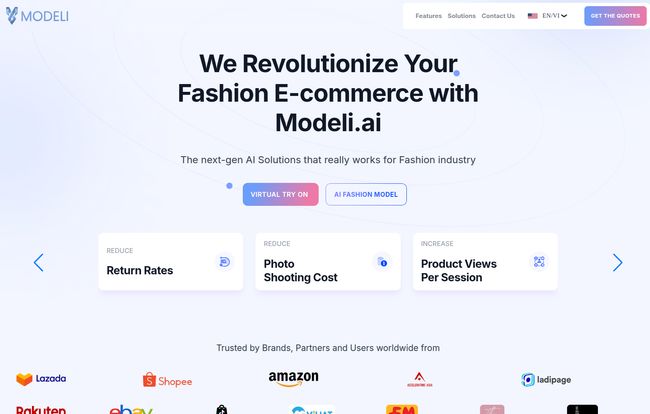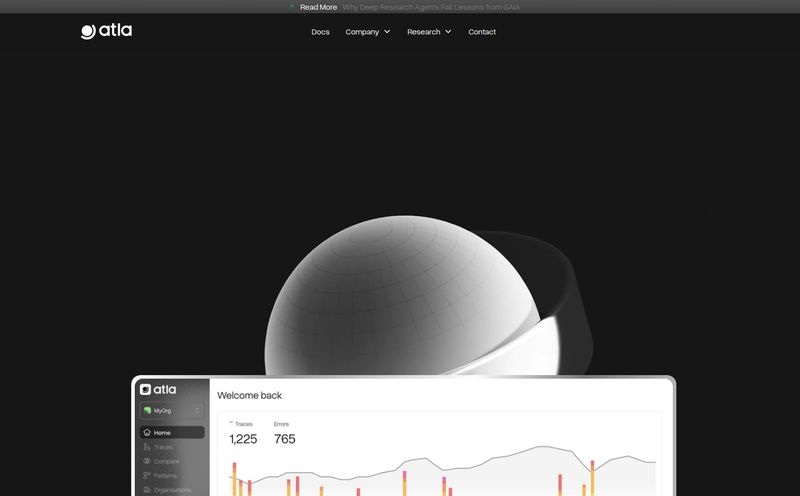Let’s have a little chat. If you've ever run a fashion e-commerce store, you know the drill. You finally get that new collection in, the fabrics feel amazing, the designs are on point. You’re excited. But then, that familiar dread creeps in. The photoshoot.
Suddenly you’re juggling model availability, finding a photographer who gets your vibe, renting a studio that isn’t a fortune, and praying the weather plays along for that one outdoor shot. I remember one time we spent a solid week and a terrifying amount of money on a shoot, only to realize half the shots had a weird lighting issue we couldn't fix. A total nightmare. It’s a massive resource drain, and for small to medium-sized businesses, it can be the single biggest barrier to getting products listed quickly.
But what if you could sidestep that whole song and dance? What if you could generate an endless supply of on-brand, high-quality model shots without ever booking a studio? This is the promise of AI model generators, and a platform called Modeli.ai has been making some serious waves. I've been in the SEO and traffic game for years, and I’m naturally skeptical of anything that promises to 10x your business overnight. But this... this is different. Let’s get into it.
So, What Exactly Is Modeli.ai?
Think of Modeli.ai as your own personal, on-demand digital modeling agency. It's an AI-powered platform designed specifically for fashion retailers. You give it a picture of your product—say, a shirt on a mannequin or even a flat lay—and its algorithm works some kind of voodoo to generate a new, photorealistic image of a model wearing that exact shirt.
It’s not just a fancy background remover or a simple face-swap. It’s creating a completely new scene from scratch. You can choose from different model styles, ethnicities, poses, and even change the background to match your store’s aesthetic. It’s pretty wild, and a far cry from the clunky AI tools of just a couple years ago.
The Big Promises: Can AI Really Replace Your Photographer?
Okay, let’s look at the claims on their website. They're throwing around some pretty big numbers: 80-90% cost savings, 4x more product images, and a 50% bump in conversion rates. As an SEO guy, that last one really caught my eye. More conversions from better images? That's the holy grail. But is it just marketing fluff?
Slashing Your Photoshoot Budget (Dramatically)
The 80-90% cost saving claim sounds insane, but when you break it down, it starts to make sense. A traditional photoshoot involves paying for a photographer, a model, a makeup artist, a stylist, studio rental, and post-production editing. This can easily run into thousands of dollars for a single collection. Modeli.ai replaces nearly all of that with a monthly subscription. The economics of it are, frankly, a no-brainer for brands on a budget.
More Images, More Angles, More Sales
This is where my SEO brain gets excited. Modeli claims you can 4x your image count. Instead of having just two or three shots per product, you can generate ten. Show the dress from the front, the side, a close-up on the fabric, and on three different models. This does two things: it gives the customer way more confidence to buy, and it gives Google more visual content to index. More high-quality images can absolutely lead to better engagement metrics, which Google loves. A 50% conversion rate increase might be on the high end, but I have no doubt that a richer image gallery would move the needle significantly. It just makes sense.
The Magic of Virtual Try-On (VTO)
This is where Modeli.ai gets really interesting. Beyond static images, they offer a Virtual Try-On feature. It allows shoppers to see what an item might look like on a model that reflects their general body type. This is a huge step toward solving the biggest problem in online fashion: returns. According to a 2021 study by the National Retail Federation, online returns cost retailers over $218 billion. If VTO can reduce even a fraction of those "it didn't fit right" returns, the tool pays for itself almost instantly. It’s an interactive element that can keep users on your page longer and build incredible purchase confidence.

Visit Modeli.ai
Getting Your Hands Dirty: How Modeli.ai Works
From what I've gathered, the process is pretty straightforward. You’re not going to need a degree in computer science to figure it out. You start with a source image. This is key—you need a clean, well-lit photo of your clothing item, ideally on a mannequin to give the AI the best information about its shape and drape.
Once you upload your source file, you get to the fun part. You can browse through different AI models, select poses, and choose from a library of backgrounds or upload your own. This customisation is brilliant for maintaining brand consistency. Want all your shots to have a minimalist, concrete loft vibe? Done. Prefer a sunny, outdoor feel? You can do that too. Then you click generate, and in a short amount of time, you have a brand new product shot ready for your store.
Let's Talk Money: The Modeli.ai Pricing Structure
Alright, the all-important question: what’s this going to cost? Their pricing page was a little confusing at first glance, focusing heavily on the "Virtual Try-On" feature, but here’s how I’ve pieced it together. It seems they offer a few tiers, primarily based on credits (where one credit likely equals one image generation).
| Plan Name | Price (Billed Annually) | What You Get |
|---|---|---|
| Freemium | $0 | 39 credits per month to test the waters. |
| Startup (VTO) | $49 / month | 149 credits per month. Great for small shops. |
| Business (VTO) | $149 / month | 599 credits per month. Built for scaling brands. |
| Enterprise | Contact for Quote | Custom solution for large-scale operations. |
Note: These prices and plans are for the Virtual Try-On feature as displayed on their site. The pricing for just the AI model generation might be different. It’s always best to check their site directly or get a quote for the most accurate details.
The Not-So-Fine Print: A Reality Check
No tool is perfect, and I wouldn't be doing my job if I didn't point out a few things to keep in mind.
The Data Caveat
First, the impressive stats about conversion lifts and cost savings seem to be pulled from small and medium-sized shops, mostly in Southeast Asia and the US. If you're a luxury brand in Milan, your results might differ. It’s not a deal-breaker, just context. The principles are sound, but the exact numbers could vary.
Garbage In, Garbage Out
Second, and this is important, the quality of your output is directly tied to the quality of your input. The old programming adage "garbage in, garbage out" applies here. If you upload a blurry, poorly lit photo of a crumpled t-shirt on your floor, the AI isn’t going to magically produce a Vogue-quality image. You still need to put in the effort to get a great source shot on a mannequin. Think of it as prep work—do it right, and the final result will be amazing.
My Final Take: Is Modeli.ai a Game-Changer for Fashion E-commerce?
So, what’s the verdict? In my opinion, Modeli.ai is genuinely a game-changer for a huge segment of the fashion ecomerce market. For startups, dropshippers, and small-to-medium brands, it’s an absolute powerhouse. It democratizes high-quality product photography, freeing up immense amounts of time and capital that can be reinvested into marketing, inventory, or, you know, sleeping at night.
Is it going to put every fashion photographer out of business tomorrow? No. High-end, artistic campaigns with a specific narrative and celebrity models will always have their place. But for the bread-and-butter product listings that every store needs? This is the future. It’s not about replacing creativity; it's about automating the grunt work so you can focus on being creative where it really counts.
Frequently Asked Questions
1. How can Modeli.ai help my fashion store?
In short, it helps you create professional model photos for your products quickly and affordably. This can save you thousands on traditional photoshoots, increase your product image variety, and potentially boost your conversion rates and reduce returns.
2. Can I integrate the Virtual Try-On with my Shopify store?
The website mentions "Seamless Integration" with your existing shopping platform. While they don't explicitly name Shopify in the main copy, it's the industry standard, so integration is highly likely. It's best to confirm with their sales team for specifics.
3. What kind of source image do I need to provide?
You need a clear, high-quality image of your apparel. The best results come from using a mannequin shot, as it gives the AI a clear understanding of the garment's shape, fit, and form.
4. Are the AI models diverse? Can I customize them?
Yes. Modeli.ai offers a variety of model templates and allows for customization of attributes like ethnicity and physical features, as well as the pose and background, to ensure they align with your brand's identity.
5. Is it really cheaper than a traditional photoshoot?
Absolutely. When you factor in the costs of a photographer, model, studio, makeup, and editing, a monthly subscription to Modeli.ai is significantly more cost-effective for generating a high volume of standard product-on-model images.
6. What's the difference between AI model generation and Virtual Try-On?
AI model generation creates static product images with an AI model. Virtual Try-On (VTO) is a more interactive feature that allows customers to visualize apparel on a model, often with options to see different sizes, which helps in reducing return rates.
Conclusion
The rise of AI in the creative space can feel a bit scary, but tools like Modeli.ai show the collaborative power of this tech. It’s not here to steal our jobs; it’s here to take away the most tedious, expensive parts of them. By making professional imagery accessible to everyone, it levels the playing field, allowing great products to shine, regardless of the owner’s budget. And that’s a future I’m definitely excited to see.



